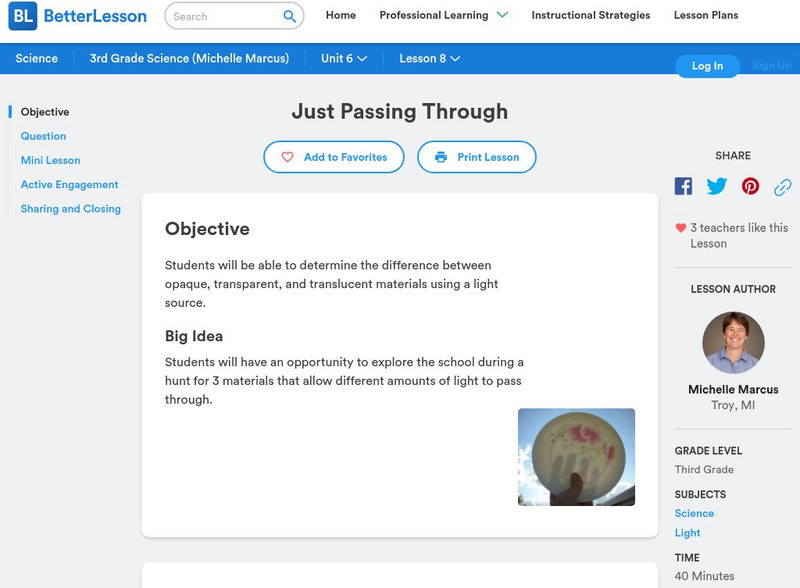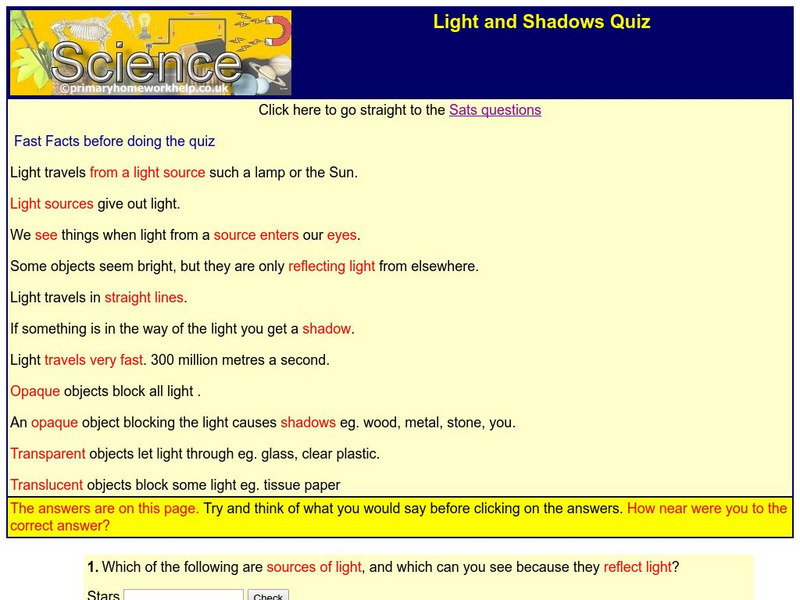Curated OER
Materials - Who Wants to Be a Millionaire?
Play a game to review characteristics of different materials. Players will compare natural to man-made materials and how much light passes through them. They consider water and heat resistance as well. If you are preparing your class for...
Curated OER
Science: The States of Matter
Third graders conduct experiments in matter to create chemical changes resulting in gases. By mixing solids and liquids, they create a chemical reaction and capture the gas in balloons. After observing the balloons fill with carbon...
Curated OER
Translucent, Transparent and Opaque Objects
Students examine different objects. For this appearance lesson, students watch a video about translucent, transparent and opaque objects. Students work in pairs to examine a bag of objects and then discuss the results.
Curated OER
Can You See the Light?
Learners investigate the transmission of light energy. In this light energy lesson, students observe bubbles using different colored filters and record their observations. They also look at a light source through various materials and...
Curated OER
Amounts of Light Passing Through Objects
In this science worksheet, students identify object around them and determine whether they are transparent, translucent or opaque. Students record their findings in the appropriate circle on the worksheet.
Curated OER
Can You See the Light?
Students differentiate transparent and translucent. In this physics lesson plan, students design an experiment to determine which material is more effective in heating container using solar energy. They collect data and share...
Curated OER
Cloud Shadows
Students classify the visual opacity of various materials, what is needed to create shadows, and classify clouds by the types of shadows that they produce.
ClassFlow
Class Flow: What Is Light?
[Free Registration/Login Required] This flipchart reviews the characteristics of light and its properties. Students are given examples of reflection, refraction, and lens types. An assessment component is included.
E-learning for Kids
E Learning for Kids: Science: Winery: Why Can We See Through Some Objects but Not Others?
Learn about the properties of materials in their interactions with light, including whether they are opaque, transparent, or translucent, and which of these produce shadows.
Better Lesson
Better Lesson: Just Passing Through
Students will have an opportunity to explore the school during a hunt for 3 materials that allow different amounts of light to pass through. Included in this lesson are videos showing the lesson in progress, examples of students' work,...
Project Britain
Primary Homework Help: Light and Shadows Quiz
This resource provides information about light and shadows. In addition, there is a short quiz that can be taken.
Alabama Learning Exchange
Alex: Geometric Shadows
Students will identify objects as translucent, transparent, or opaque. Upon seeing the shadow of the opaque object, students will identify the geometric figure created by the shadow.This lesson plan was created as a result of the Girls...
Alabama Learning Exchange
Alex: Translucent, Transparent, and Opaque Objects
Students will become familiar with transparent, translucent, and opaque objects. Students predict whether items are transparent, translucent, or opaque. Finally, students will show what they have learned by producing a song, poem, cheer,...
Ducksters
Ducksters: Physics for Kids: Light
Kids learn about the science of light. Energy made of waves and particles called photons traveling at the top speed in the universe. What is refraction? The difference between transparent, translucent, and opaque.
ClassFlow
Class Flow: Light and Shadows
[Free Registration/Login Required] This unit introduces the relationship between light, an object and the formation of shadows.

















